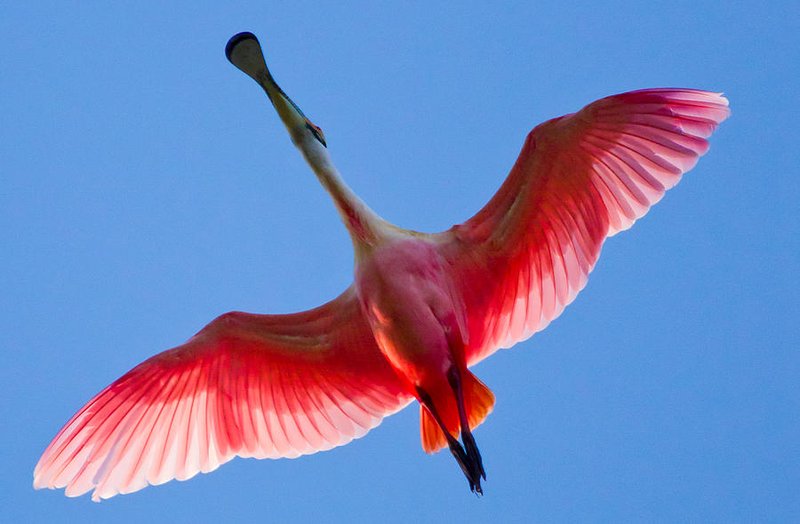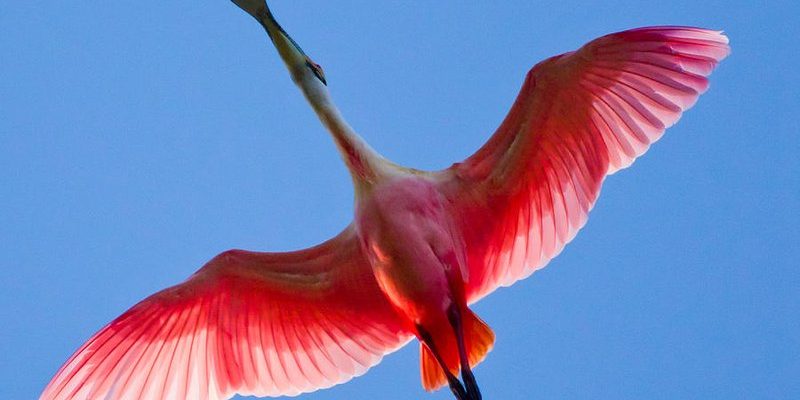
The Roseate Spoonbill is like a splash of cotton candy against the backdrop of wetlands and marshes. With its vibrant pink feathers and unique spoon-shaped bill, this striking bird captures the attention of anyone lucky enough to spot it. Imagine a graceful dancer gliding over the water, searching for food with that funky-looking bill—there’s just something so playful about it!
These social birds often gather in flocks, making them a delightful sight during a nature walk or birdwatching adventure. But beyond their beautiful appearance, Roseate Spoonbills play a vital role in their ecosystems. They help maintain the health of wetland environments, showing us just how interconnected all living things really are.
Physical Characteristics
The first thing you notice about the Roseate Spoonbill is, of course, its stunning plumage. Adult birds display a range of pink hues, from soft pastel shades to deeper, more vibrant tones. Their coloration can vary based on diet, with those feeding on certain crustaceans exhibiting brighter feathers. Can you imagine using dinner to decide your outfit for the day? That’s exactly what these birds do!
In terms of size, a typical Roseate Spoonbill stands about 30 to 34 inches tall, with a wingspan reaching up to 50 inches. They have long legs perfect for wading through shallow waters and a long neck that makes it easier to spot food beneath the surface. Their bill is particularly fascinating—broad and flat, it resembles a pan or spoon, hence the name. This unique shape allows them to sift through mud and shallow waters, capturing small fish and invertebrates effectively.
| Size: | 30 to 34 inches tall |
| Wingspan: | Up to 50 inches |
| Color: | Vibrant pink, with variations based on diet |
| Habitat: | Marshes, wetlands, and coastal areas |
| Diet: | Small fish, crustaceans, and insects |
| Lifespan: | About 10 to 15 years in the wild |
Habitat and Distribution
Roseate Spoonbills thrive in various wetland environments, including marshes, estuaries, and mangrove swamps. These habitats provide them with the food and nesting sites they need to survive. They are primarily found in the southeastern United States, Central America, and parts of South America. The sight of them wading through shallow waters, searching for their next meal, is a common one in places like Florida’s Everglades or Texas’s coastal marshes.
You might wonder why wetlands are so crucial for these lovely birds. Well, they are teeming with life! The muddy waters are rich in nutrients, supporting a wide range of aquatic species. Roseate Spoonbills position themselves in these environments to take advantage of the ample food supply while also benefiting the ecosystem by controlling insect populations and helping with nutrient cycling. It’s a win-win for them and the environment!
Behavior and Social Structure
When it comes to behavior, the Roseate Spoonbill is quite the social butterfly—or should I say, social spoonbill? They are known to congregate in large flocks, especially during foraging and nesting seasons. These gatherings can range from a handful of birds to hundreds, creating a beautiful scene as they feed and interact together. Watching them take flight in a synchronized dance is simply breathtaking.
During the breeding season, these birds form monogamous pairs and engage in elaborate courtship displays. You’ll see them preening, calling, and even performing short flights to attract mates. Nesting typically occurs in trees or shrubs in colonies, where they build platform nests using twigs and grasses. It’s a real family affair, as both parents share responsibilities in incubating eggs and caring for their young.
Diet and Feeding Habits
The diet of the Roseate Spoonbill primarily consists of small fish, crustaceans, and aquatic invertebrates. They have a unique feeding technique that sets them apart from other birds. By swinging their bills side to side in the shallow waters, they can detect and capture prey effectively. It’s almost as if they’re using their spoons to sift through the soup of life beneath the surface!
Seasonal changes can influence their diet as well. During the warmer months, when the water levels drop, these birds tend to forage in the shallower areas where food is abundant. This adaptability makes them successful hunters in their environments. You could say these birds have a knack for going where the food flows!
Conservation Status
Despite their captivating beauty, Roseate Spoonbills have faced challenges due to habitat loss and environmental changes. Wetland destruction caused by urban development, pollution, and climate change has significantly impacted their populations. Conservation efforts are essential to protect these beautiful birds and their habitats.
Organizations and wildlife agencies are actively working to restore and preserve wetland areas, ensuring that Roseate Spoonbills and other wildlife can continue to thrive. Public awareness also plays a significant role. By promoting eco-friendly practices and supporting conservation initiatives, we can help protect these remarkable creatures for future generations.
Fun Facts About Roseate Spoonbills
- Did you know that the Roseate Spoonbill is closely related to flamingos? They both belong to the same family, but their feeding habits set them apart.
- Their diet impacts their coloration; a diet rich in carotenoid pigments found in crustaceans leads to brighter feathers.
- These birds are quite vocal, making a range of sounds including honks and grunts to communicate with each other.
- The Roseate Spoonbill has been a symbol of wetland conservation and is featured in many environmental campaigns.
FAQ
Where can I find Roseate Spoonbills in the wild?
If you want to catch a glimpse of Roseate Spoonbills, head to wetlands, marshes, or coastal areas in the southeastern United States, especially Florida and Texas. Birdwatching in these regions can reveal scores of these stunning birds in their natural habitat.
What is the lifespan of a Roseate Spoonbill?
In the wild, Roseate Spoonbills typically live between 10 to 15 years. However, their lifespan can vary based on environmental factors and threats from predators or habitat loss.
Are Roseate Spoonbills endangered?
While they are not currently classified as endangered, Roseate Spoonbills are protected under the Migratory Bird Treaty Act in the United States. Their population is monitored, and conservation efforts are ongoing to protect their habitats and ensure their survival.
What do Roseate Spoonbills use their unique bills for?
The distinctive spoon-shaped bill of the Roseate Spoonbill is perfectly adapted for foraging. They sweep their bills side to side in shallow water, capturing small fish and invertebrates. It’s like using a spatula to flip pancakes—only this spatula is for hunting dinner!
How do Roseate Spoonbills communicate?
Roseate Spoonbills use a variety of vocalizations to communicate with one another. They can produce honks, grunts, and even some soft croaking sounds. These calls are essential for maintaining social connections, especially in large flocks.
Do Roseate Spoonbills migrate?
Generally, Roseate Spoonbills are resident birds, meaning they tend to stay in the same area year-round. However, some populations may migrate short distances, especially if food resources become scarce during the colder months.
What factors threaten the Roseate Spoonbill’s habitat?
Several factors threaten Roseate Spoonbills, including wetland destruction due to urbanization, water pollution, and climate change. These threats make it crucial to protect and restore wetland habitats to ensure their survival.
Can Roseate Spoonbills swim?
While Roseate Spoonbills are primarily waders and do not swim like ducks, they can occasionally paddle through water when needed. They prefer shallow areas where they can wade and forage for food rather than swimming.
How do Roseate Spoonbills care for their young?
Both parent Roseate Spoonbills take turns incubating their eggs and caring for the chicks once they hatch. The young birds fledge after about 6–7 weeks, but they may stay with their parents for a while longer to learn essential survival skills.
How can I help with Roseate Spoonbill conservation?
Supporting local conservation organizations, participating in clean-up events, and spreading awareness about the importance of wetlands are all ways you can help protect Roseate Spoonbills and their habitats. Every little bit counts in the fight for wildlife conservation!

